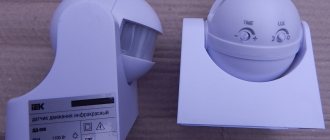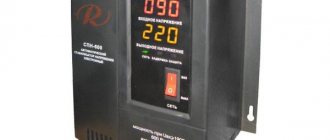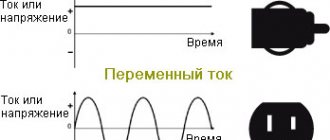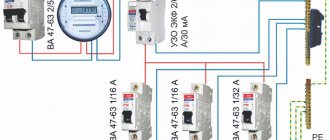Documentation
In his work, the OPS electrician relies on the job description, the legislation of the Russian Federation, as well as regulations adopted by the enterprise.
The employee reports to the immediate management or director of the organization, depending on the hierarchy in the company.
The job description must contain a list of duties, requirements, rights and responsibilities that are assigned to the employee.
Familiarization with the document occurs at the time of acceptance to the position, as well as in the event of changes to any of the documents.
An employee who has qualifications corresponding to the Unified Tariff and Qualification Handbook of Works can become an electrician.
Designation on circuit diagrams
The main symbols that are used in the case of overcurrent discharge devices are presented in the following image. The first symbol is a general arrester, the second is a tubular arrester, the third is a valve and magnetic valve arrester, and the last is a surge suppressor.
Designation on the circuit diagram
Groups of electricians
There are five groups into which employees of this position are divided. Each category specifies its own requirements and responsibilities associated with permits to work with electrical equipment.
The categories of OPS electricians are divided into the third, fourth, fifth, sixth. The highest is the sixth. For this category of employees, the highest degree of responsibility is established, and their powers are the broadest. The third category is the lowest; employees with this category may have specialized secondary education and bear minimal responsibility due to the simplicity of the assigned work.
An electrician of a higher qualification must know everything that an electrician of a lower category must know. This statement is relevant for all ranks except the lowest, the seventh.
SPD - surge protection device
To bookmarks
Purpose of SPD
Surge protection device (SPD) is a device designed to protect the electrical network and electrical equipment from overvoltages that can be caused by direct or indirect lightning effects, as well as transient processes in the electrical network itself.
In other words, SPDs perform the following functions :
— Protection against lightning strikes of the electrical network and equipment, i.e. protection against overvoltage caused by direct or indirect lightning effects
— Protection against surge voltages caused by switching transients in the network associated with turning on or off electrical equipment with a large inductive load, such as power or welding transformers, powerful electric motors, etc.
— Protection against remote short circuit (i.e. against overvoltage resulting from an existing short circuit)
[Advertising] The Priborenergo company produces high-quality surge protectors with an emphasis on reliability.
SPDs have different names: network surge suppressor - OPS (OSN) , surge voltage limiter - OIN , but they all have the same functions and operating principle.
[Advertising] You can buy surge protectors of high reliability and quality on the website etirussia.ru
Appearance of the SPD:
Operating principle and protection device of SPD
The operating principle of the SPD is based on the use of nonlinear elements, which, as a rule, are varistors.
A varistor is a semiconductor resistor whose resistance has a nonlinear dependence on the applied voltage.
Below is a graph of the dependence of the varistor resistance on the voltage applied to it:
The graph shows that when the voltage increases above a certain value, the resistance of the varistor decreases sharply.
Let's look at how this works in practice using the following diagram as an example:
The diagram shows a simplified representation of a single-phase electrical circuit, in which a load in the form of a light bulb is connected through a circuit breaker, an SPD is also included in the circuit, on one side it is connected to the phase wire after the circuit breaker, on the other - to ground.
In normal operating mode, the circuit voltage is 220 Volts, at this voltage the SPD varistor has a high resistance measured in thousands of MegaOhms, such a high resistance of the varistor prevents the flow of current through the SPD.
What happens when a high voltage pulse occurs in a circuit, for example, as a result of a lightning strike (thunderstorm).
The diagram shows that when a pulse occurs in the circuit, the voltage increases sharply, which in turn causes an instantaneous, multiple decrease in the resistance of the SPD (the resistance of the varistor of the SPD tends to zero), the decrease in resistance leads to the fact that the SPD begins to conduct electrical current, short-circuiting the electrical circuit by land, i.e. creating a short circuit that causes the circuit breaker to trip and shut down the circuit. Thus, the surge suppressor protects electrical equipment from the flow of a high voltage pulse through it.
SPD classification
According to GOST R 51992-2011, developed on the basis of the international standard IEC 61643-1-2005, there are the following classes of SPDs:
SPD class 1 - (also designated as class B ) are used for protection against direct lightning effects (lightning strike into the system), atmospheric and switching overvoltages. They are installed at the entrance to the building in the input distribution device (IDU) or the main distribution board (MSB). Must be installed for free-standing buildings in open areas, buildings connected to an overhead line, as well as buildings with a lightning rod or located next to tall trees, i.e. buildings with a high risk of being directly or indirectly affected by lightning. Normalized pulse with a waveform of 10/350 μs. The rated discharge current is 30-60 kA.
SPD class 2 - (also designated as class C ) are used to protect the network from residual atmospheric and switching overvoltages passing through a class 1 SPD. They are installed in local distribution panels, for example in the input panel of an apartment or office. They are normalized by pulse current with a waveform of 8/20 μs. The rated discharge current is 20-40 kA.
SPD class 3 - (also designated as class D ) are used to protect electronic equipment from residual atmospheric and switching overvoltages, as well as high-frequency interference passing through a class 2 SPD. They are installed in branch boxes, sockets, or built directly into the equipment itself. An example of the use of SPDs of the 3rd class are network filters used to connect personal computers. They are normalized by pulse current with a waveform of 8/20 µs. The rated discharge current is 5-10 kA.
SPD marking - characteristics
SPD characteristics:
- Rated and maximum voltage - the maximum operating voltage of the network for operation under which the SPD is designed.
- Current frequency - operating frequency of the network current for the operation at which the SPD is designed.
- Rated discharge current (the current waveform is indicated in parentheses) is a current pulse with a waveform of 8/20 microseconds in kiloamperes (kA), which the SPD is capable of transmitting many times.
- The maximum discharge current (the current waveform is indicated in parentheses) is the maximum current pulse with a waveform of 8/20 microseconds in kiloamperes (kA) that the SPD is capable of transmitting once without breaking down.
- Protection voltage level is the maximum value of the voltage drop in kiloVolts (kV) across the SPD when a current pulse flows through it. This parameter characterizes the ability of the SPD to limit overvoltage.
SPD connection diagram
A general condition when connecting an SPD is the presence of a fuse or circuit breaker corresponding to the network load on the supply network side, therefore all the diagrams presented below will include circuit breakers (see the SPD connection diagram in the electrical panel here):
Schemes for connecting SPDs (OPS, OIN) to a single-phase 220V network (two-wire and three-wire):
Schemes for connecting SPDs (OPS, OIN) to a three-phase 3800V network
Schematic diagrams for connecting an SPD are as follows:
When installing multi-stage overvoltage protection , i.e. installation of 1st class SPDs in the building's ASU together with 2nd class SPDs in the distribution boards of the building and with 3rd class SPDs, for example, in sockets, it is necessary to maintain a distance between the SPDs along the cable of at least 10 meters:
Was this article useful to you? Or maybe you still have questions ? Write in the comments!
Didn’t find an article on the website on a topic that interests you regarding electrical engineering? Write to us here. We will definitely answer you.
↑ Up
10
https://elektroshkola.ru/apparaty-zashhity/uzip/
Required knowledge
Each category serves a certain type of equipment and performs its job responsibilities. Depending on their clearance, electricians perform more precise and responsible work or perform smaller duties.
For example, the instructions for a third-class OPS electrician require him to know:
- device and rules of technical data of the equipment being serviced;
- the procedure in which the performance of monitoring and control systems is checked;
- rules for routing cables in boxes, cabinets, boxes and drawers;
- methods in which detectors are mounted;
- rules for working with the simplest tool, which is used when installing alarm systems at entrusted facilities;
- methods used to look for malfunctions in the alarm system, as well as methods for eliminating them;
- basics of electrical engineering;
- fire safety rules;
- instructions for keeping the workplace in order;
- main types of deviations of operating modes from normal;
- requirements for the use of basic protective equipment;
- procedures for preventing dangerous situations;
- rules for providing first aid to victims in case of injury, poisoning or sudden illness;
- rules aimed at environmental protection;
- internal labor regulations;
- rules of sanitation, hygiene, health and safety.
The personal qualities required to work in this position include punctuality, scrupulousness, responsibility, and the ability to work in difficult conditions.
Technical characteristics of OPS-1
OPS-1 is a series of switching surge suppressors that protect networks from harmful impulses. Structurally, they have standard modules with an 18 mm width for installation on a mounting rail. They contain solid-state composite varistors made of zinc carbide and mechanisms responsible for visual monitoring of the wear of the varistor and emergency fuse. Thanks to zinc carbide, the resistance is reduced by 1000 times when a voltage appears on the replacement module, the value of which exceeds the maximum permissible.
OPS 1
Each OPS-1 has a number of modules from 1 to 4 pieces in a single-phase and three-phase network. There is a class, a rated voltage, an operating protector voltage (500-1000 volts), a rated amount of limiter current (5-10 amperes), a current that the arrester accepts during an atmospheric discharge (40-65 kiloamperes) and a voltage to which the value decreases upon rupture (from 0.25 to 1.2 kilowatts).
Note! There are four protection classes. The first class of devices is not used in domestic installations, but is needed only to protect the electrical transmission line. The second class is used to protect high voltage surges that are caused by lightning striking an electrical transmission line.
The third class is needed to protect against overvoltages with low network values. Protective devices are installed in household switchgear. The fourth class is used to protect electrical devices that are sensitive to impulse noise and surges in a single-phase network. They are mounted in a distribution panel, behind an outlet in an electrical box or near the protected device.
Specifications
Responsibilities
The job description of the OPS electrician instructs him to perform the following work:
- alarm line repair and line maintenance;
- inspecting cable routes;
- cleaning contacts and contactors, cords, switches, buttons and other main and auxiliary equipment;
- laying lines and hanging lines according to simple patterns;
- soldering and installation of branch, connecting and end couplings;
- checking the installation using simple instruments;
- elimination of defects that appeared during the assembly of simple circuits;
- carrying out maintenance, installation, adjustment, and repair of devices;
- attaching detectors to building structures using screws, staples, dowels;
- installation of tap boxes, laying wires in boxes and along building structures;
- digging special trenches, work to carry out auxiliary activities;
- checking the functionality of active and passive detectors and elements of access control and monitoring systems.
Explanation of the abbreviation and basic operating principle
OPS-1 stands for in electrical engineering as a system surge suppressor. The device works simply. Often acts as a fire alarm.
Abbreviation
The main element of the unit is a varistor, which is a special electrical conductor. Passes electric current through itself, which has increased many times over the rated voltage. As a result, the load is shunted, transformed and dissipated. Thermal energy or heating of the housing is created. In most cases, there is a window through which you can visually determine the performance of the varistor. This device also has a fuse designed to protect equipment from overcurrents.
You might be interested in SPD installation - connection diagrams, installation rules
Basic operating principle
Rights
Regardless of what category the OPS electrician has, he has the right to:
- providing him with personal protective equipment, necessary tools and materials, a workplace equipped according to his needs;
- creating a comfortable working environment and conditions that comply with labor safety standards;
- informing immediate management about shortcomings that have been identified in the company’s activities within the framework of its responsibilities;
- making proposals to eliminate detected faults.
Connection diagrams
The example below shows the correct zonal connection of a surge suppressor. This scheme is very effective. It is the concept of three-stage protection, where the device is placed indoors, that is extremely popular in practice. In this case, for each zone a corresponding restrictive class is assigned.
Please pay attention! When installing equipment, it is necessary to maintain a reasonable distance between devices. They should be approximately 10 meters closer to each other. This point is indicated by each ops 1 connection diagram.
Connection diagram
In general, OPS-1 is a surge protection device designed to protect an electrical circuit from short-term voltages between phase and ground. Pulse overvoltages appear both inside and outside the network. OPS-1 stands for pulse limiter and has its own basic operating principle. Conventionally indicated on the circuit diagram by a rectangle. Presented differently in connection diagrams.
Responsibility
The OPS electrician is responsible for performing his direct duties. In addition, in his activities he is responsible for:
- improper performance or failure to perform the work listed in the job description;
- non-compliance with health and safety rules, internal regulations, fire safety;
- violation of the safety of material and technical valuables entrusted to him;
- causing material damage to the organization, in this paragraph liability is determined within the framework of current legislation.
Vacancies
Working as an electrical installer requires a high level of responsibility. Employees in different regions of the country can expect different salary levels. However, most often for this position the pay level is set at 15,000 rubles.
If there is a vacancy in a large company, the candidate needs to understand that he will be responsible for a system that protects a large number of people.










